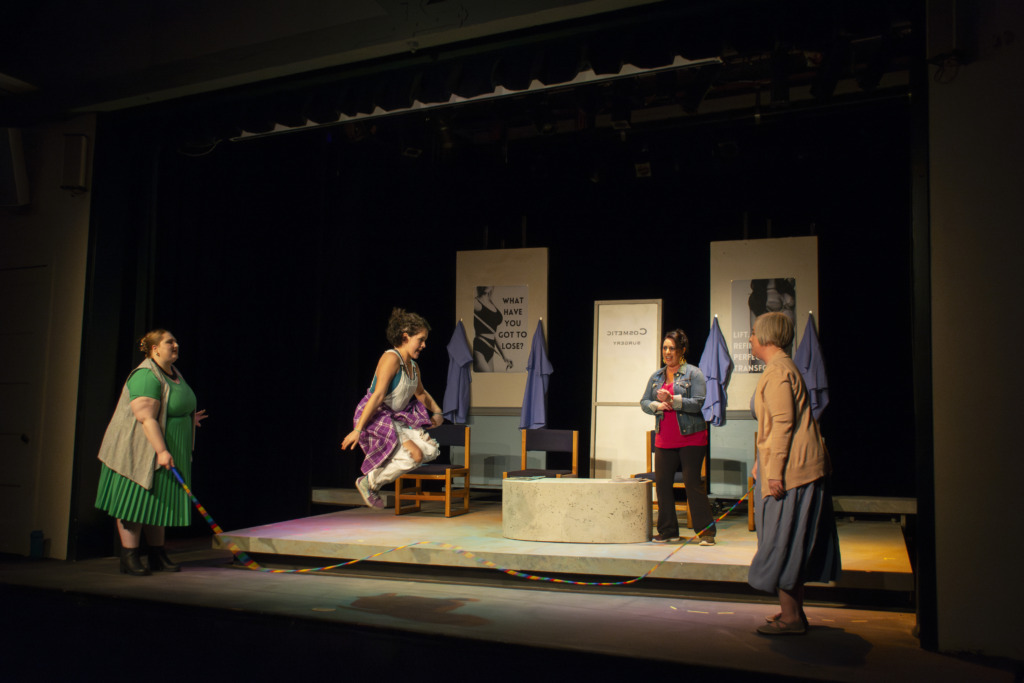Everyone likes appetizers. Or hors d’oeuvres. Tapas? Small, delicious bites of flavorful morsels to tease the palette and titillate the senses. Well if that isn’t exactly what Manor Mill Playhouse has on their stage this weekend— earmarking their second-ever production— with Manor Mill Playhouse Shorts, three one-act plays with three different directors, three different sets of actors, and one deeply impressive evening of performances. Produced by Vanessa Eskridge, the evening’s spread has three unique stories on offer, a little something for everyone, if you will.

Applause and praise are due first and foremost to Scenic Designer Carol Oles, who has designed a multi-faceted, multi-functional set that functions for seven different plays. (Yes, it’s only three one-acts, but as the first one-act encompasses four different performance-shows, it’s a rather unique situation.) Oles has a rake-tilt base with a teal-glowing ghost light as her start and it all blossoms from there. The balcony from Private Lives and the chopping block from A Man For All Seasons are whisked on and off, utterly transforming from the cobbled-together nature that is needed for the first show— Christopher Durang’s The Actor’s Nightmare— into a rustic log-cabin style homestead, complete with bucolic and derelict furnishings from another time for the evening’s second offering— Susan Glaspell’s Trifles. Oles’ set transforms for a third time, complete with decorated walls of a surgery clinic to bring the audience readily into the evening’s third show, a modern-day drama— Madeleine Geroge’s The Most Massive Woman Wins. There’s a brilliant run crew (Celia Bowers, Aurora Brown, Delaney Culbreth Mathew Hazelhurst, Adelaide Longlois-Marney, Colby Simpson) that keeps these scenic transitions running smoothly and efficiently. Considering how elaborate the set ends up looking, particularly for the shift between the first show and the second (where there is not an intermission) this is handled with an impressive swiftness. Shoutout to Sound Designer Cory Richard Davolos for the transitionary music to cover these moments as well. And Lighting Designer Cat Bustos keeps her illuminating craftsmanship simple and effective. The teal glow from the ghost light at the top of the show is curious in an intriguing fashion and the ‘snap spots’ used for The Actor’s Nightmare feel wholly authentic to the type of comedic response the story is trying to achieve.
Costuming across the board, by way of Designer Kim Melvin, suits each show sublimely. The period pieces fitted, in particular for the women of Trifles, draw the audience into the temporal shift from the first piece to the second and from the second to the third. The elaborate costumes, especially the use of velvet or velour in the two dresses and Horatio outfit from The Actor’s Nightmare give that ‘theatrical elegance’ verve whilst Melvin’s selection of ‘modern wear’ for The Most Massive Woman Wins, including the sterile uniformity of the surgical prep-gowns, helps the audience better relate to the four characters contained within. While each production offers something different, given the extreme emotional gravity of the third offering and the ominous weight of the second, Producer Vanessa Eskridge could have considered a slight shuffle in the running order, if only to create somewhat more of a balance for the audience’s experience. Both sides can be argued— ending on the most emotionally impactful production certainly leaves the audience stunned but as it was immediately preceded by an equally dark and unsettling piece, one wonders if the ‘comedy’ of the three might have been better served as the second performance. The shows themselves are exceptionally well performed, spaced, conceptualized and delivered; it’s ultimately an exceptional experience of small-town professional theatre.
The Actor’s Nightmare directed by Vanessa Eskridge; stage managed by Juliet Jones
A quirky comedy with titular relevance, The Actor’s Nightmare by Christopher Durang is exactly that. An actor— George (Austin Heath)— appears on stage being barked at by a Stage Manager (Jeanea Blair) to ‘fill-in’ as the actual actor has had some accident, only the actor has no idea what play he’s being asked to fill-in for, and in true dream-nightmare fashion, it’s all of them. Or in this case, four of them. Director Vanessa Eskridge keeps the pacing of this production galloping along, much like an actual nightmare where things happen so quickly you can’t be sure if you’re dreaming or awake or caught somewhere between the two.

Austin Heath, as the titular actor, does a stupendous job of displaying nerves. His face reddens, his limbs shake, his voice trembles; all of the hallmarks and signature responses of someone in way over their head are readily visible in Heath’s portrayal. The more desperate he grows, the more humorous the situation become and Heath never loses sight of this metric as the performance progresses. Jeanea Blair, serving as ‘Meg the Stage Manager’ who pops in and out of the four plays as various participants is a grounding presence for poor George’s unsteady nerves and she understands the importance of timing, especially as it pertains to entrances and exits.
Over-the-top melodrama arrives to this production in the form of M. Eden Walker, when she first storms her way backstage as Sarah Siddons, who turns into Amanda from Private Lives and Gertrude from Hamlet with equal parts “I-AM-ACTING!” flourish in her hammy sensationalism. Matching her energy but in a very different vein, Lauren Meley appears as Cybele in the Private Lives segment, but much more noticeably in that god-awful trashcan-play from Beckett. Meley’s antics in this role are ripe with uproarious laughter, particularly as she force-reads her character’s stage directions, jerking about in her trashcan like a janky, half-rusted animatronic from some long-abandoned theme park. There’s also the dashing arrival of Horatio (Anthony Ocampo) in the Hamlet segment of this performance, played with grounded gusto the likes of which seem unmatchable. Ocampo, who first arrives backstage with a firm chip on his shoulder and an attitude for miles, slips into this bravado-strong performance, catching the eyes and the attentions of everyone in the audience. When he shifts into ‘the executioner’ it’s like watching a mind-blowing magic trick; that’s how distinctly differential his performance is.
Trifles directed by Matthew Sean Mitchell; stage managed by Jennifer Barnette Parker
This ominous drama, set in Northeast Iowa in the winter of 1909 comes to the stage by way of playwright Susan Glaspell and seems to be the most ‘out of sorts’ of the three shows being presented. It’s extremely well delivered, well-timed and paced, but just doesn’t thread tightly enough to either one of the shows sandwiched on either side of it. Matthew Sean Mitchell’s direction falls in line with that of Eskridge’s from The Actor’s Nightmare, though the pacing here feels less important to the progress of the play as a whole. The cast of five— Andy Belt, William Kohlhoff, Frank Mancino, Amanda Polanowski, and Wendy Snow— have icy character relationships with the women sticking to themselves and the men sort of existing around them. Belt’s character, a brassy, guff-laden detective or unspecified officer of the law, stomps in and out of the space determined to make his point, which appears to mostly be slagging on the women over how they make such a fuss over such trifles like quilting and preserved fruit. Frank Mancino, as Lewis Hale, has quite the knack for storytelling and his character does exactly that, recounting the tale of his encounter with a character, which he does in such vivid detail that you feel almost as if you’re waiting for her to exist in the cast of characters. William Kohlhoff’s character of Henry Peters seems simply to exist, not particularly observant nor possessed with drive as Belt’s George Henderson is.

Amanda Polanowski, as the sweetly worrisome Mrs. Peters and Wendy Snow as the heartier, more seasoned Mrs. Hale, are where the intrigue in this tale lies. Polanowski and Snow have effective body language and silent shared glances that speak volumes about the circumstances, the— trifles— that the men are too oblivious to notice. And when they start expressing themselves, privately among themselves, you get to the heart of Glaspell’s play. Both Polanowski and Snow have a firm handle on the speech patterns of turn-of-the-century, midwestern, homesteaders. And the emotional fortitude with which they imbue their respective characters is quite striking.
The Most Massive Woman Wins directed by Chloe Brush & Emily Decker; stage managed by Hannah Byron
Arguably the most blind-siding piece of the trio on showcase, The Most Massive Woman Wins by Madeleine George is an evocative and rather gripping tale of four ‘everywoman’ types who all find themselves sitting together in the waiting room of a cosmetic surgery office. At first it seems like it might be a fluffy piece about how to just embrace who you are and love your body regardless. Get that notion quickly out of your head and prefer for the devastator-grade gravity-bomb that gets dropped just a few minutes into the performance as these four insanely talented actors show the traumas of body-shaming, the toxic language and environment in which women have always existed when it comes to their relationships with food and with their bodies, and ultimately how a woman’s body is a beautiful thing at every and any size.

Directors Chloe Brush & Emily Decker utilize the claustrophobic-feeling office waiting room space extremely well when it comes to spatial alignment, spatial awareness and emotional significance. Using hot-light-drop-cues (shoutout again to Cat Bustos and her grand lighting design) to momentarily draw focus on these women, along with the heavily implemented use of the ticking clock sound effect (props to Cory Richard Davolos’ sound design), you get a fully-rounded intense theatrical experience, which makes the words being delivered by these four sensational performers that much more impactful.
Featuring Sandra Bulk, Jane R. Frazier, Mira Lamson Klein, and Madison Sims, the play takes turns putting these women in the spotlight, each delivering a harrowing and brutal monologue about how and why their character ended up in the ‘cosmetic surgery waiting room’. Before getting to these powerhouse deliveries of stunning monologues, the women take turns playing as children with these darkly damning children’s rhymes— like the one about people being disgusted by Cinderella’s girdle busting— whilst jumping rope. They run through every-day childhood activities— the scoliosis screening in gym class, playing sports, jumping rope— and all of the toxic and traumatizing, bullying things that kids say to other kids because of their bodies.
Sandra Bulk’s character is sassy and maternal all at once, delivering this passionate monologue about teen pregnancy and how it correlates to body-type while Jane R. Frazier deals with the latter-end of aging, particularly when symptoms that sound a lot like menopause creep into play and how men just don’t get it, and blame weight on everything. Mira Lamson Klein delivers a stunning monologue on the desperation of craving touch and yet hating herself for wanting it while Madison Sims’ character anecdotally explains eating disorders. They each have astonishing moments with exhilarating capacities to captivate the audience, drawing them into their stories in a far too relatable way. It’s an extraordinary piece of theatre, and these four women all but bring the house down when they do their ‘gown-drop’ at the conclusion of their performance, standing confident and proud; it’s extraordinary.
This series of three short plays runs for just one weekend but is certainly delivering high quality and high caliber theatre to northeastern Baltimore County. Be sure to catch Manor Mill Playhouse Shorts this weekend!
Running Time: 2 hours and 20 minutes with one intermission
Manor Mill Playhouse Shorts plays through April 6th 2025 in The David Niven Theater at Oldfields School— 1500 Glencoe Road in Spark-Glencoe, MD. Tickets are available at the door or in advance online.



